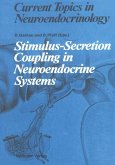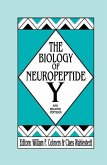The Peptidergic Neuron (eBook, PDF)
Redaktion: Krisch, B.
72,95 €
72,95 €
inkl. MwSt.
Sofort per Download lieferbar

36 °P sammeln
72,95 €
Als Download kaufen

72,95 €
inkl. MwSt.
Sofort per Download lieferbar

36 °P sammeln
Jetzt verschenken
Alle Infos zum eBook verschenken
72,95 €
inkl. MwSt.
Sofort per Download lieferbar
Alle Infos zum eBook verschenken

36 °P sammeln
The Peptidergic Neuron (eBook, PDF)
Redaktion: Krisch, B.
- Format: PDF
- Merkliste
- Auf die Merkliste
- Bewerten Bewerten
- Teilen
- Produkt teilen
- Produkterinnerung
- Produkterinnerung

Bitte loggen Sie sich zunächst in Ihr Kundenkonto ein oder registrieren Sie sich bei
bücher.de, um das eBook-Abo tolino select nutzen zu können.
Hier können Sie sich einloggen
Hier können Sie sich einloggen
Sie sind bereits eingeloggt. Klicken Sie auf 2. tolino select Abo, um fortzufahren.

Bitte loggen Sie sich zunächst in Ihr Kundenkonto ein oder registrieren Sie sich bei bücher.de, um das eBook-Abo tolino select nutzen zu können.
- Geräte: PC
- ohne Kopierschutz
- eBook Hilfe
- Größe: 41.9MB
Andere Kunden interessierten sich auch für
![Molecular Neurobiology (eBook, PDF) Molecular Neurobiology (eBook, PDF)]() Nicolas G. BazanMolecular Neurobiology (eBook, PDF)112,95 €
Nicolas G. BazanMolecular Neurobiology (eBook, PDF)112,95 €![Stimulus-Secretion Coupling in Neuroendocrine Systems (eBook, PDF) Stimulus-Secretion Coupling in Neuroendocrine Systems (eBook, PDF)]() Stimulus-Secretion Coupling in Neuroendocrine Systems (eBook, PDF)72,95 €
Stimulus-Secretion Coupling in Neuroendocrine Systems (eBook, PDF)72,95 €![The Serotonin Receptors (eBook, PDF) The Serotonin Receptors (eBook, PDF)]() Elaine Sanders-BushThe Serotonin Receptors (eBook, PDF)72,95 €
Elaine Sanders-BushThe Serotonin Receptors (eBook, PDF)72,95 €![Neuroregulation of Autonomic, Endocrine and Immune Systems (eBook, PDF) Neuroregulation of Autonomic, Endocrine and Immune Systems (eBook, PDF)]() Neuroregulation of Autonomic, Endocrine and Immune Systems (eBook, PDF)232,95 €
Neuroregulation of Autonomic, Endocrine and Immune Systems (eBook, PDF)232,95 €![Central Regulation of the Endocrine System (eBook, PDF) Central Regulation of the Endocrine System (eBook, PDF)]() Central Regulation of the Endocrine System (eBook, PDF)40,95 €
Central Regulation of the Endocrine System (eBook, PDF)40,95 €![Adenosine and Adenosine Receptors (eBook, PDF) Adenosine and Adenosine Receptors (eBook, PDF)]() Michael WilliamsAdenosine and Adenosine Receptors (eBook, PDF)160,95 €
Michael WilliamsAdenosine and Adenosine Receptors (eBook, PDF)160,95 €![The Biology of Neuropeptide Y and Related Peptides (eBook, PDF) The Biology of Neuropeptide Y and Related Peptides (eBook, PDF)]() William F. ColmersThe Biology of Neuropeptide Y and Related Peptides (eBook, PDF)112,95 €
William F. ColmersThe Biology of Neuropeptide Y and Related Peptides (eBook, PDF)112,95 €-
-
-
Produktdetails
- Verlag: Springer Basel
- Seitenzahl: 356
- Erscheinungstermin: 6. Dezember 2012
- Englisch
- ISBN-13: 9783034890106
- Artikelnr.: 53102324
Dieser Download kann aus rechtlichen Gründen nur mit Rechnungsadresse in A, B, BG, CY, CZ, D, DK, EW, E, FIN, F, GR, HR, H, IRL, I, LT, L, LR, M, NL, PL, P, R, S, SLO, SK ausgeliefert werden.
- Herstellerkennzeichnung Die Herstellerinformationen sind derzeit nicht verfügbar.
I. General considerations on peptidergic neurons.- Retrospective and prospectives for research on neurosecretion.- Patterns of peptide discharge - implications for Dale's principle.- The paraneuron revisited.- II. Biosynthesis, release and degradation of neuropeptides.- Role of convertases in the processing of neuropeptides and neurotrophins.- Biosynthesis of neuropeptides in cnidarians: evidence for unusual neuropeptide precursor processing enzymes.- Evidence for a receptor-mediated mechanism for sorting proopiomelanocortin to the regulated secretory pathway.- Molecular mechanisms of neurotransmitter and neuropeptide release.- Scanning electron microscopy of an active neurohaemal area, the cockroach (Periplaneta americana) corpora cardiaca: looking at neurosecretion from an unprecedented viewpoint.- Varicosity formation and non-synaptic release of large core vesicles in the co-culture of neuronal and smooth muscle cells.- Cell-surface peptidases involved in neuropeptide metabolism: an overview.- The TRH-degrading ectoenzyme: a putative signal-terminator within the central nervous system and adenohypophyseal regulator of hormone secretion.- The function of glial cells in the inactivation of neuropeptides.- III. Neuropeptide receptors.- Molecular biology of peptide receptors.- Reduction of somatostatin-14 binding to the rat somatostatin receptor subtype 3 by Na+ is enhanced by mutation of the glutamate residue 92 in the transmembrane domain II.- Somastatin receptor subtypes in human astrocytes and gliomas: Influence of cultivation process.- Coexistence of angiotensin receptors and angiotensin in hypothalamic neurons of the rat.- Bradykinin binding sites on isolated cultured dorsal root ganglion cells demonstrated with gold-labelled bradykinin.- IV. Comparativeaspects.- The invertebrate neurosecretory cell: state of the art.- Neurotrophin-like immunoreactivity in the nervous system of the earthworm Eisenia foetida (Annelida, Oligochaeta).- The Met-callatostatins of the bowfly Calliphora vomitoria: post-translational modifications, neuronal mapping and functional significance.- Secretory stimulation induces the preferential release of newly synthesized peptide hormones by the neuroendocrine adipokinetic cells of Locusta migratoria.- Tachykinin- and FMRFamide-like immunopositive neurons in the developing central complex of the beetle Tenebrio molitor.- Comparative aspects of neurohypophyseal hormone genes.- V. Signal transduction and integrative system.- Signal transduction and second messengers in neurosecretory cells.- Multi-signal transduction of moth pheromone biosynthesis-activating neuropeptide (PBAN) and its modulation: Involvement of G-proteins?.- Analysis of the effect of pituitary adenylate cyclase-activating polypeptide (PACAP) on growth hormone (GH) secretion in GH3 cells.- Expression of vasotocin gene during metamorphosis in the bullfrog hypothalamus.- Basal-medial hypothalamus conducts the development of GnRH neurons.- VI. Behavioural effects of neuropeptides.- Behavioural effects of neuropeptides: central and peripheral nechanisms of action of vasopressin.- Effects of tank colour and stress on melanin-concentrating hormone gene expression in the rainbow trout.- Endocrine influence on vasopressin-enhanced retrieval of a passive avoidance response.- Functional evidence for a transmission of peptides along the olfactory systems into the brain in healthy humans.- C-type natriuretic peptide (CNP) in the mammalian pineal gland: An endogenous autocrine peptide?.- VII. Neuropeptides in immune defense and pathology.- Therole of neuropeptides in immunoregulatory processes.- Neuropeptides in hypothalamic pathology.- Impact of somatostatin receptor scintigraphy in differential diagnosis of meningeoma.- Uptake of I-125 radiolabelled dynorphin in glioma cell cultures.- Parathyroid hormone-related protein (PTHrP) - a paracrine factor in astrocytes and an autocrine factor in astrocytomas.- Author index.
I. General considerations on peptidergic neurons.- Retrospective and prospectives for research on neurosecretion.- Patterns of peptide discharge - implications for Dale's principle.- The paraneuron revisited.- II. Biosynthesis, release and degradation of neuropeptides.- Role of convertases in the processing of neuropeptides and neurotrophins.- Biosynthesis of neuropeptides in cnidarians: evidence for unusual neuropeptide precursor processing enzymes.- Evidence for a receptor-mediated mechanism for sorting proopiomelanocortin to the regulated secretory pathway.- Molecular mechanisms of neurotransmitter and neuropeptide release.- Scanning electron microscopy of an active neurohaemal area, the cockroach (Periplaneta americana) corpora cardiaca: looking at neurosecretion from an unprecedented viewpoint.- Varicosity formation and non-synaptic release of large core vesicles in the co-culture of neuronal and smooth muscle cells.- Cell-surface peptidases involved in neuropeptide metabolism: an overview.- The TRH-degrading ectoenzyme: a putative signal-terminator within the central nervous system and adenohypophyseal regulator of hormone secretion.- The function of glial cells in the inactivation of neuropeptides.- III. Neuropeptide receptors.- Molecular biology of peptide receptors.- Reduction of somatostatin-14 binding to the rat somatostatin receptor subtype 3 by Na+ is enhanced by mutation of the glutamate residue 92 in the transmembrane domain II.- Somastatin receptor subtypes in human astrocytes and gliomas: Influence of cultivation process.- Coexistence of angiotensin receptors and angiotensin in hypothalamic neurons of the rat.- Bradykinin binding sites on isolated cultured dorsal root ganglion cells demonstrated with gold-labelled bradykinin.- IV. Comparativeaspects.- The invertebrate neurosecretory cell: state of the art.- Neurotrophin-like immunoreactivity in the nervous system of the earthworm Eisenia foetida (Annelida, Oligochaeta).- The Met-callatostatins of the bowfly Calliphora vomitoria: post-translational modifications, neuronal mapping and functional significance.- Secretory stimulation induces the preferential release of newly synthesized peptide hormones by the neuroendocrine adipokinetic cells of Locusta migratoria.- Tachykinin- and FMRFamide-like immunopositive neurons in the developing central complex of the beetle Tenebrio molitor.- Comparative aspects of neurohypophyseal hormone genes.- V. Signal transduction and integrative system.- Signal transduction and second messengers in neurosecretory cells.- Multi-signal transduction of moth pheromone biosynthesis-activating neuropeptide (PBAN) and its modulation: Involvement of G-proteins?.- Analysis of the effect of pituitary adenylate cyclase-activating polypeptide (PACAP) on growth hormone (GH) secretion in GH3 cells.- Expression of vasotocin gene during metamorphosis in the bullfrog hypothalamus.- Basal-medial hypothalamus conducts the development of GnRH neurons.- VI. Behavioural effects of neuropeptides.- Behavioural effects of neuropeptides: central and peripheral nechanisms of action of vasopressin.- Effects of tank colour and stress on melanin-concentrating hormone gene expression in the rainbow trout.- Endocrine influence on vasopressin-enhanced retrieval of a passive avoidance response.- Functional evidence for a transmission of peptides along the olfactory systems into the brain in healthy humans.- C-type natriuretic peptide (CNP) in the mammalian pineal gland: An endogenous autocrine peptide?.- VII. Neuropeptides in immune defense and pathology.- Therole of neuropeptides in immunoregulatory processes.- Neuropeptides in hypothalamic pathology.- Impact of somatostatin receptor scintigraphy in differential diagnosis of meningeoma.- Uptake of I-125 radiolabelled dynorphin in glioma cell cultures.- Parathyroid hormone-related protein (PTHrP) - a paracrine factor in astrocytes and an autocrine factor in astrocytomas.- Author index.







